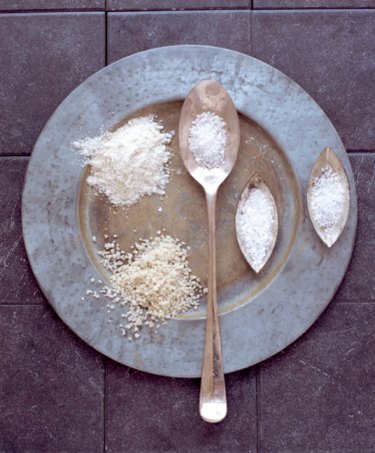
Often neglected or underestimated, salt is essential to seasoning food, an ingredient missed when it's underused and detested when it's overdone. To salt food correctly, you must understand how food responds to it. There are several methods of salting food, most importantly "to taste." Other methods include curing, brining and salt crusting.
To Taste
Video of the Day
Taste serves as the most important barometer for measuring salt. Most recipes designed for the home cook prescribe the amount of salt to incorporate into a preparation – that amount should be considered a recommendation. Always salt a preparation before, during and after cooking. The chemistry of food changes as it heats, and when a liquid reduces, the salt concentration increases. For instance, when preparing a basic tomato sauce, add just enough salt to detect it. Then 20 minutes later, taste the sauce, and add more salt if needed to bring it just below your personal preference. As the sauce finishes, taste again. Add more salt if desired.
Video of the Day
Curing
Salt curing, also referred to as corning (as in corned beef), is one of the simplest and most effective methods of preserving meat. In addition to its preservation properties, salt curing contributes flavor elements and assists in producing a moist and juicy final product. This results from two processes – osmosis and diffusion. Osmotic pressure draws moisture to the surface of the meat, killing bacteria in the process. Diffusion acts as an equalizer and returns the moisture to the interior of the meat and disperses it throughout. For a salt cure, cover the meat heavily with a coarse salt, such as kosher, and refrigerate it for a minimum of 12 hours. When you're ready to prepare it, scrape the salt from the meat, rinse it under cool running water, and pat it dry with paper towels before you cook it.
Brining
Brines, similar to salt cures, serve as a preservation method, a flavor enhancement and a tenderizing agent for meat. Brines work on the same principles as salt cures – diffusion and osmosis. Cooks brine several meats, most commonly pork, poultry and fish. Muscle cells take in moisture from the brine, causing them to swell and retain water during the cooking process. The standard brine consists of 1 qt. of water, 1/2 cup of kosher salt and 1/2 cup of white granulated sugar. However, several options exist for adding flavor elements to the meat via brine. For instance, adding three whole cloves, one star anise pod, three cardamom pods and five black peppercorns to the standard brine will impart taste and aromatic qualities redolent of the spices used. Pour the brining solution into a nonreactive container, submerge the meat, place it in the refrigerator and allow it to brine for one hour per pound, not to exceed eight hours.
Salt Crusting
Salt crusting refers to covering an item, most commonly vegetables or meats, with a thick layer of salt and baking it. The salt essentially seals the food, trapping steam – and moisture – inside. If salt crusting a fish (whole fish works very well when roasted in a salt crust), first coat it with a thin layer of olive oil and place it in a baking dish. Pack 1/4 inch of kosher or sea salt over its surface, press and repeat once more. Ensure that the salt is tightly packed, but do not press so hard as to damage or compress the fish. Bake a 4-lb. fish for 30 minutes in a 450 degree Fahrenheit oven. After removing it, crack the salt crust with a wooden spoon and remove it from the fish. Drizzle the fish lightly with extra virgin olive oil prior to serving it. The salt crust alleviates the need to season the fish further, and the flesh inside will have a moistness unattainable with dry roasting.
Vegetables
Salt raw vegetables with a coarse salt, such as sea or kosher. Unlike meat, do not salt vegetables prior to cooking; this draws out moisture and results in a wilted final product. Season vegetables to taste during the cooking process.